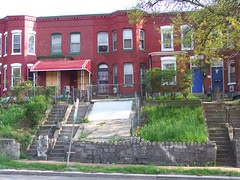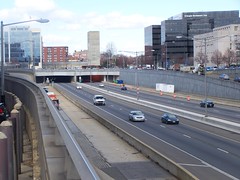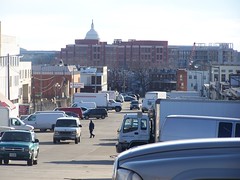Brookland planning
I have been meaning to write about the hearing from a couple weeks ago, but I didn't have the right photos to illustrate some of the points I wanted to make, and now the moment is passed so I am less inclined to write the overly thorough kind of entry that I am noted for.
One of the things that can bug me about citizen involvement in civic affairs has to do with agreeing to a set of facts. You know the line: you're entitled to your own opinion, but not to your own set of facts.
One of the things that keeps coming up is "decking" the Brookland Metro station and how the Office of Planning ignored that option. (Which they didn't. Even though they knew it wasn't feasible, they paid an extra $50,000 for a economic and basic engineering analysis of the possibility.)
This whole idea of decking is cockeyed, and anyone with a basic spatial sense should be able to figure it out.
1. From Rhode Island Avenue to the District line in Silver Spring, for the most part the CSX and WMATA red line subway tracks are at grade, even as it is slightly below or slightly above grade in various places on the route.
2. I wrote a long blog entry in the summer of 2007 evaluating the idea of the original proposal, which was to tunnel and put the Brookland station underground.
Frankly, I think that would be great, but would cost billions of dollars because the weight of the locomotive engines and train cars is such that you can't abruptly shift tracking grade. The entire Metropolitan branch tracks would have to be put underground to make this work--from Union Station in DC to some point in Montgomery County, I don't know how far.
Had this been done in the early 1970s when the subway line was constructed, this might have been feasible. It isn't now, even though it's a great idea and would allow for adding tracks to the subway line.
3. That led to the decking idea as an alternative. And people tout the fact that the National Capital Planning Commission is promoting decking of freeways in various places in the city.
But as you can see from this photo, I-395 is in a below grade ditch and can be decked at the normal street grade level.

When Union Station was constructed, many grade changes were made to accommodate the creation of the train yard, bridges for the tracks, and underpasses for the streets. This particularly impacted blocks between 2nd and 3rd Streets from about F Street NE to L Street NE. These houses on the 200 block of K Street NE were likely built with an even grade to the street, although now they are perched significantly higher than street level today.
4. Because the Met Branch is not under grade in a significant fashion, you can't deck it and create "new land" at street grade level in the same way that this has been done above I-395 already.

Looking east from the E Street overpass of I-395 you can see how buildings have been constructed between H and K Streets NW, on top of a deck over the I-395 freeway.
5. Therefore, if you create a "deck" in Brookland you create another obstruction, one that creates another problem.
And the whole point of putting the Brookland station and tracks in that vicinity underground had to do with trying to knit the east and west parts of the neighborhood together (oddly, this is somewhat problematic because for the most part, the west parts of the neighborhood are made up of institutional campuses and don't lend themselves very well to connection).

This isn't a perfect comparison. It's taken from 5th and Penn Street NE, at the top of Florida Market. While I like the quality of the apartment buildings constructed at Senate Square (the 200 block of I Street NE), there is no question that they have impacted the quality of the viewshed of the dome of the U.S. Capitol from various locations in the northeast quadrant. A "deck" at the Brookland Metro station would merely be a big building blocking views and acting as an obstruction.
6. Another point made frequently by the pro-deck faction is that lots of land would be created by decking and this would generate income.
But the reality is that for the most part, from Rhode Island Ave. to the DC-Silver Spring line, the railroad track right-of-way is about 150 feet wide maximum. You don't create all that much developable land, and certainly not enough to cover the cost of tunneling. (CSX would likely happily give up the revenue/rights to sale of the land in return for a tunnel that they wouldn't have to pay for, but building a tunnel might require significant service interruptions in the interim.)
Traditional Metro tunnels cost $400 million/mile--and with this idea by contrast we are talking about double stacked tunnels with the CSX railroad tracks on the bottom, but wider than Metro tunnels, since we would likely want to increase by at least one the number of tracks for both the railroad and the subway line. So the cost would be significantly higher.
Why can't the PhDs and the architects and other professionals in Brookland understand these conditions and constraints? These "facts"?
(Sadly, why didn't the subway station at Brookland get designed better in the first place, recognizing the possibility of extending the grid, and maintaining the idea of Newton as a through street? This would have solved many problems. The thing is that the planning proposals for changes to the Metro station likely will never happen because they are too costly, and the development rights around the station aren't valuable enough to generate the amount of money required to do even this, let alone contribute significant revenue to WMATA from land sales.)




0 Comments:
Post a Comment
<< Home